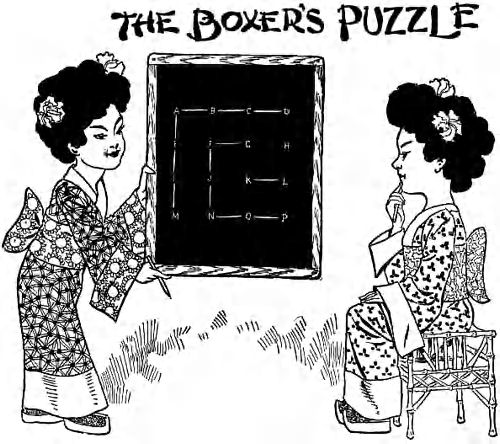



HERE IS AN ODD little puzzle-game from the East which is played upon lines very similar to the well-known game of “Tit, Tat Toe, three in a row.” One of the Chinese girls writes sixteen letters on a slate in four rows, as shown, and after marking a straight dash, which connects A to B, passes the slate to her opponent, who connects E with A. If the first player should now connect E with F the other player would connect B with F and score “one box,” and have the right to play again. But they have played so well that neither one has yet scored a box, although each has played six times, but the game is reaching a critical point where one of them must win, for there are no draws in this play, as in other games. The little maiden sitting down has to play now, and if she connects M and N her opponent could score four boxes in one run, and then having the right to one more play would connect H and L, which would win all the rest. What play would you now advise, and how many boxes will it win against the best possible play of the second player?
Remember, that when a player scores a “box,” he plays again. Suppose for example a player marks from D to H, as the game shows on the slate. Then the second player marks from H to L, and then no matter what mark the first player makes, the second player scores all nine boxes without stopping. It is a game that calls for considerable skill as you will discover after trying a few games. But in the game shown on the slate, where each player has made six marks, you are asked to tell what is the best play now to be made and how many boxes will it surely win?
This odd little puzzle-game proved to be replete with opportunities for surprises and fine points of play, as shown in the following answer, which proves that the first player should score seven boxes by beginning with a line from G to H. If the second player then marks from J to K, the first will score two boxes by marking from K to O and P to L, and will then play the waiting move, L to H, instead of scoring two more boxes. The other player now scores the two boxes by G and K, and is then compelled to make a play which gives the first player five others. If, when the first player marks from G to H, the second player marks C-G, B-F, E-F, and then makes the waiting play of M-N, which scores four more boxes. It is this sharp play of giving your opponent two boxes so as to then get four which constitutes the pretty points of the game.
2.
What's the difference between a bee and a donkey? One gets all the honey, the other gets all the whacks.
Why is the letter N like a pig? Because it makes a sty nasty.
What must you add to nine to make it six? S, for IX with S is six.
Twice ten are six of us,
Six are but, three of us,
Nine are but four of us,
What can we possibly be?
Would you know more of us?
I’ll tell you more of us:
Twelve are but six of us.
Five are but four, do you see?
If you asked the Alphabet to come to dinner, which letters could not accept your kind invitation till later in the evening? The last six, as they couldn’t come till after T.
What kind of a cravat would a hog be most likely to choose? A pigs-tye of course.
A man bought two fishes, but on taking them home found he had three; how was this? He had two — and one smelt.
Why is a room full of married people like an empty room? Because there is not a single person in it.
Which one of the United States is the largest and most popular? The state of matrimony.
[Page 104]